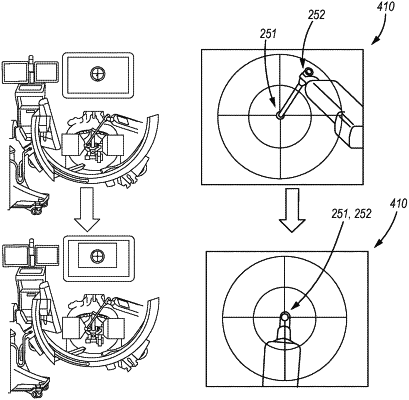| CPC A61B 34/20 (2016.02) [A61B 34/25 (2016.02); A61B 2034/2048 (2016.02); A61B 2034/2065 (2016.02)] | 21 Claims |

|
1. A surgical navigation system comprising:
a surgical tool comprising:
an instrument shaft having a distal end opposite to and distal from a proximal end of the instrument shaft;
at least one sensor unit configured to produce positional information representing a three-dimensional orientation of the instrument shaft in a real space of the surgical navigation system; and
one or more processors configured to determine a three-dimensional orientation of the instrument shaft in a virtual space of the surgical navigation system, the determination comprising:
identifying an origin point of the instrument shaft in the virtual space based on a positional information describing a position of the distal end of the instrument shaft relative to a surgical location;
determining a point in the virtual space corresponding to the proximal end of the instrument shaft based on positional information describing a position of the proximal end in the real space;
determining the three-dimensional orientation of the instrument shaft in the virtual space based on the origin point of the instrument shaft in the virtual space and the point in the virtual space corresponding to the proximal end of the instrument shaft;
determining first plane positional information corresponding to an orientation of the instrument shaft in a first plane;
determining a first-plane difference between the orientation of the instrument shaft in the first plane and a target first plane orientation;
determining second plane positional information corresponding to an orientation of the instrument shaft in a second plane; and
determining a second-plane difference between the orientation of the instrument shaft in the second plane and a target second plane orientation; and
a user interface configured to display:
the three-dimensional orientation of the instrument shaft in the virtual space; and
a target three-dimensional orientation of the instrument shaft in the virtual space, the target three-dimensional orientation representing a default orientation for operating the surgical tool at the surgical location, wherein the displayed target three-dimensional orientation further comprises the target first plane orientation and the target second plane orientation; and
an alignment between the three-dimensional orientation of the instrument shaft in the virtual space and the target first plane orientation and the target second plane orientation, wherein the user interface dynamically updates the displayed difference in response to angular movement of the instrument shaft about a starting point of the instrument shaft in the real space and dynamically updates an endpoint of a trajectory of the instrument shaft in the virtual space;
an indicator line in the virtual space, wherein the user interface is configured to receive an input to change an indicator line trajectory of the indicator line by rotating the indicator line about the starting point; and
an imaging device configured to capture a lateral X-ray image of the surgical location in response to the three-dimensional orientation of the instrument shaft in the virtual space aligning with the target three-dimensional orientation of the instrument shaft in the virtual space, wherein the lateral X-ray image captures anatomy at the surgical location and the instrument shaft, wherein the one or more processors are further configured to perform:
utilizing three-dimensional positional information corresponding to a three-dimensional orientation of the imaging device when taking a first X-ray image to determine an orientation of the instrument shaft in the first plane passing through the surgical location; and
utilizing three-dimensional positional information corresponding to a three-dimensional orientation of the imaging device when taking a second X-ray image to determine an orientation of the instrument shaft in the second plane passing through the surgical location.
|